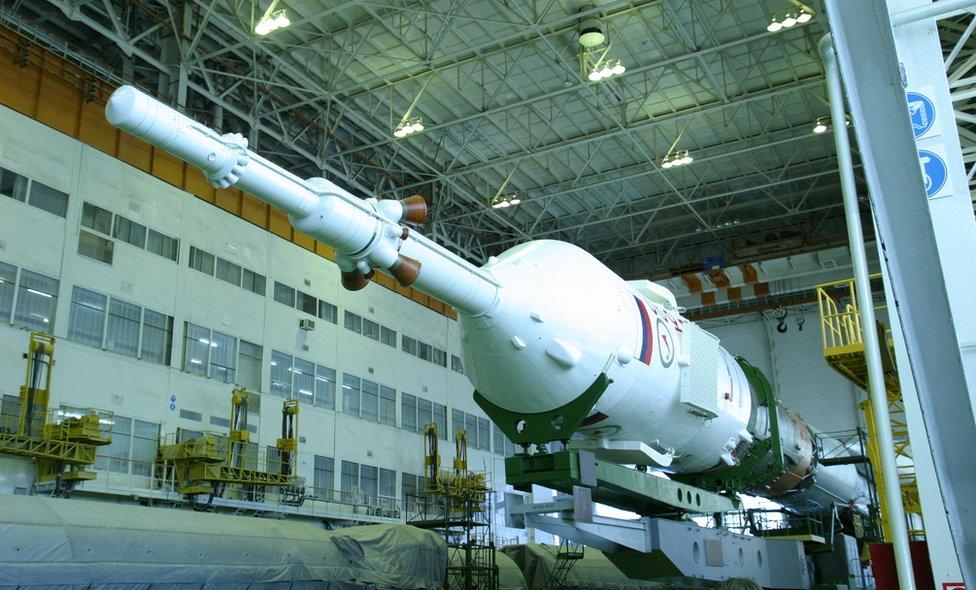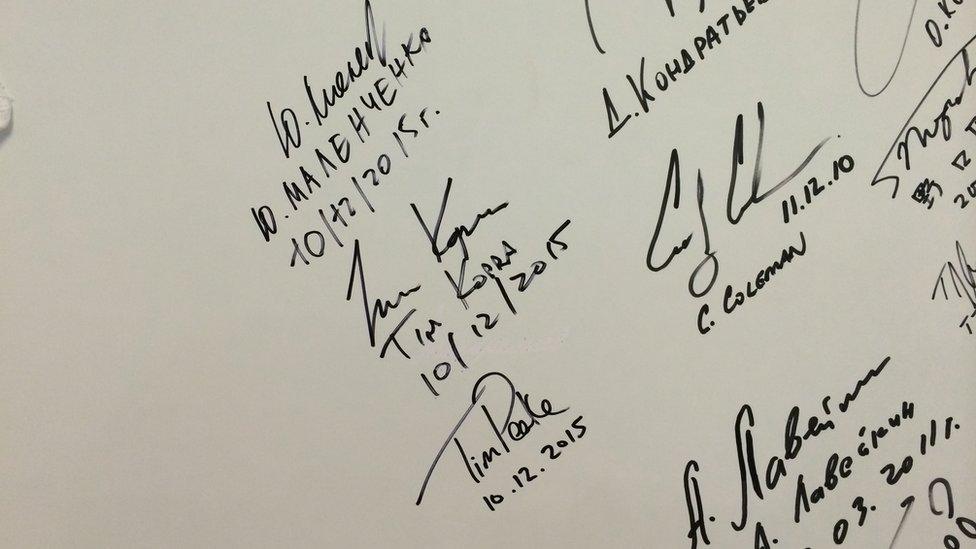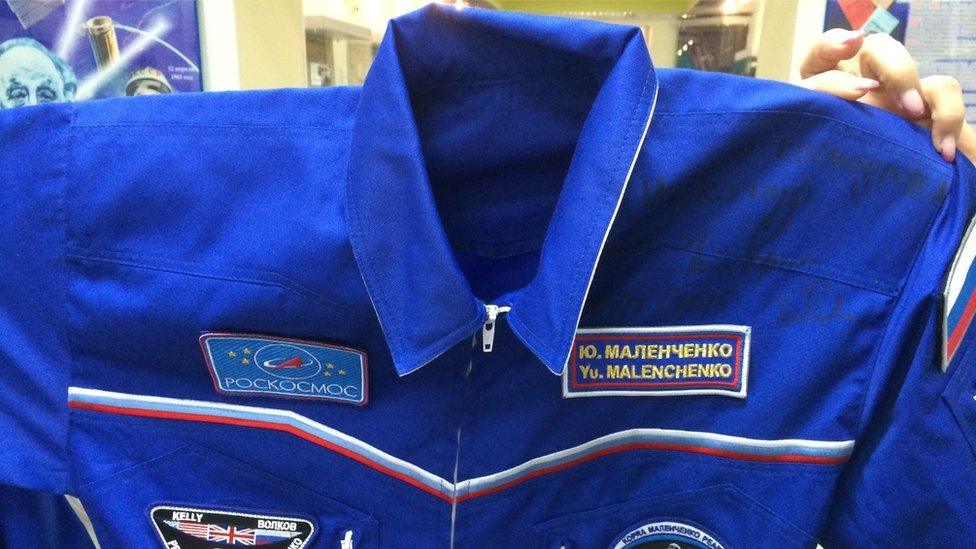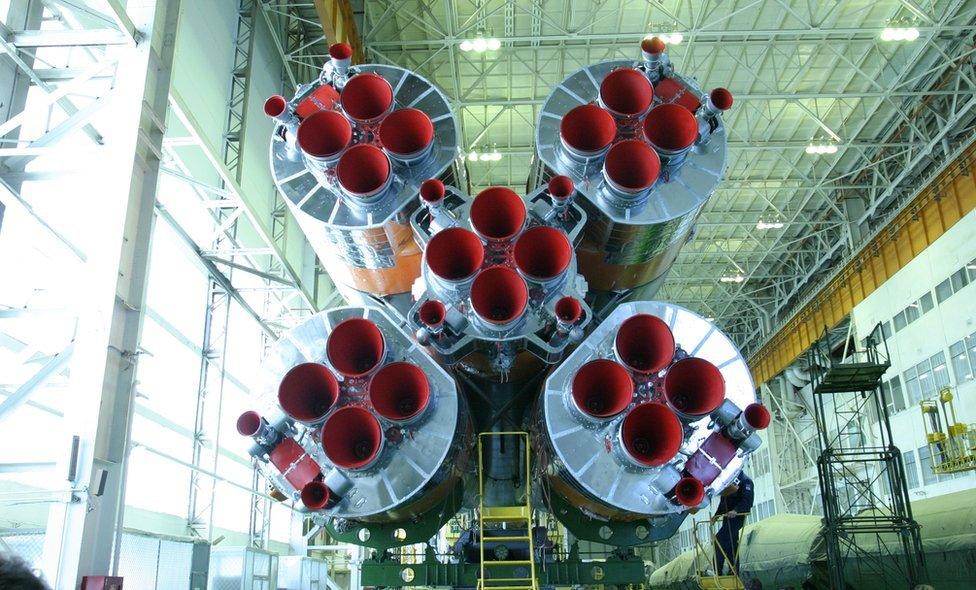Tim Peake: Astronaut's rocket assembled in Kazakhstan
- Published

The Soyuz crew module was attached to its rocket on Saturday
The Russian Space Agency has finished assembling the space vehicle that will blast UK astronaut Tim Peake into orbit.
On Saturday, the Soyuz crew module was attached to its rocket at Baikonur Cosmodrome in Kazakhstan.
We watched as the completed vehicle was loaded onto a flat-bed transporter, ready to be carried to the launch pad.
Mr Peake and two other crew members will launch to the International Space Station on Tuesday 15 December.
During his seven-month stay on the orbiting outpost, the former Army helicopter pilot will carry out a programme of experiments and educational activities.
He will be accompanied on the flight by Russian cosmonaut Yuri Malenchenko and US astronaut Timothy Kopra.
'Very different environment'
The Soyuz spacecraft - which carries the crew to the ISS - and its rocket are assembled at adjacent facilities at Baikonur Cosmodrome in Kazakhstan.
On Friday, the crew module was transported by train from its assembly site - known as Building 254 - to the huge hangar-like facility designated Building 112.
More than 40 years ago, Building 112 housed a giant (105m-high) rocket known as the N-1, which was to have taken cosmonauts to the Moon. Now the facility houses the Soyuz launcher which, at 50m long, is half the size of the N-1, and is now the workhorse of Russia's manned spaceflight programme.
'The Soyuz rocket is a living beast!'
At 09:00 local time on Saturday morning, specialist engineers began work to bond the crew module to the rest of the launcher. They finished at about 14:00.
I watched as the rocket was loaded on to a giant flat-bed transporter painted racing green. On Sunday, the transporter will be hauled by train along the railway tracks that snake across the flat steppe of Baikonur to the launch pad where Peake, Malenchenko and Kopra will begin their journey.

Follow the launch
The BBC has had unique behind-the-scenes access to Tim Peake's training and launch.
Follow his video diaries on Horizon - Tim Peake Special: How To Be An Astronaut and watch the launch live on Blast Off Live - A Stargazing Live Special at 10:30 GMT on Tuesday 15 December.
You can also see him arrive on the International Space Station, at 19:00 GMT the same evening, on BBC Two in Stargazing Live: Brit In Space.

For Tim Peake, the flight is the culmination of a three-year programme of training that has seen him travel between Houston, Florida, Moscow and Tsukuba in Japan.
"It's a long process and we cover such a huge variety of subjects," he told the BBC recently.
"One of the challenges [for astronauts] is to retain all that information as you're going through the training process and appreciate that the next time you're going to see something is in 18 months or 24 months time in space - in a very different environment."

On Tuesday, Mr Peake will be the first astronaut to fly under the banner of the European Space Agency
In 2009, Mr Peake was chosen from a pool of 8,000 applicants to join the European Space Agency (ESA) astronaut training programme, along with five other recruits.
The former Army helicopter pilot is the first Briton to be selected as an ESA astronaut.
During his seven-month stay on the outpost, Mr Peake will carry out a programme of experiments in medical science, radiation physics and materials. He is also using the mission to raise the profile of science among young people.
Human spaceflight

Tim Peake added his signature to the museum wall - a cosmonaut tradition

Russian cosmonaut Yuri Malenchenko has donated his space suit to the Baikonur museum
On Tuesday, as tradition dictates, Mr Peake, Mr Malenchenko and Mr Kopra signed the wall at the museum in Baikonur Cosmodrome. Mr Malenchenko also handed over a signed cosmonaut suit to museum staff.
Mr Malenchenko is one of the Russian Space Agency's (Roscosmos) most experienced cosmonauts, having clocked up some 641 days in space over the course of five flights.
During this mission, he will become only the third person to have spent more than 800 cumulative days in space after fellow cosmonauts Sergei Krikalev and Gennady Padalka - who holds the record of 879 days.
The BBC looks inside Russian space hero Yuri Gagarin's pre-flight living quarters
The UK government has traditionally been opposed to financing human spaceflight - so prospective British spacefarers have been required to take other routes into orbit.
Helen Sharman - who became the first British citizen to fly to space when she visited the Mir space station in 1991 - was funded by private enterprise and by the Soviet government.
Other Britons have flown either as private individuals - including Richard Garriott - or have taken out US citizenship, such as Piers Sellers and Nicholas Patrick.
Follow Paul on Twitter., external

The business end: Four booster rockets are arranged around a central core